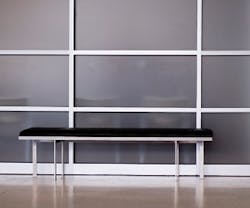If you can see through the notion that the only use for glass is in a window, you’ll find that glass can be a valuable material option for interior walls and partitions in your buildings.
All Surfaces Available
Depending on how the glass is treated prior to installation, it can be a viable option anywhere in a building. “It can be tempered as well as annealed or laminated for extreme safety,” says Mandy Brame Marxen, vice president of marketing at Gardner Glass Products. “As an interior wall or partition, it’s hard to think of a reason why you wouldn’t be able to use glass.”
Translucent (and opaque) glass products are great as demountable partitions, in reception areas and conference rooms, or as stairs and treads. How the glass is treated or fabricated governs where the glass can be used.
For instance, safety codes may prevent certain types of glass from being in a particular area. If a building code indicates that glass should be tempered, you can’t use annealed glass in that application. “A wall installation that’s installed and supported completely along the entire back surface doesn’t need to be tempered,” Marxen says. “However, a partition would need to be tempered or laminated because of the exposure; someone could accidently fall through the surface.”
Minimal Maintenance
Compared to drywall and other building materials, glass is a low-maintenance option. “From the standpoint of aesthetic value, it’s more durable than a lot of the products that could be considered in its place,” says Tommy Huskey, CEO of Gardner Glass Products. “Normally, painted walls have to be repainted every few years as a result of scratch marks and handprints.” Glass doesn’t fade, doesn’t scratch easily, and doesn’t need to be repainted.
“In commercial environments, it’s practical to keep its form in high-traffic areas,” elaborates Marxen. “It’s incredibly easy to clean graffiti off of glass, and clean dirt and grime off with common cleaners. Paint, crayons, and permanent markers can easily be removed. And because it’s often installed as large pieces with limited seams, there are no grout lines to scrub.”
Glass is Green
Glass is a green choice, and not just in color. “When walls are parallel to a building exterior, glass walls allow more natural light to be shared by occupants,” says Chris Dolan, director of commercial glass products at Guardian Industries. “Increasing access to natural light helps qualify a project for LEED points, saves energy, and provides a better experience for the building occupants.”
In addition, there are LEED opportunities for using decorative glass in acoustic control. “Glass can [offer] sound reduction within interior spaces,” Marxen says. Laminated glass is especially good for absorbing sound. While most people think that glass would do the opposite (with sound waves bouncing all over), that’s not necessarily the case, explains Marxen.
Permits Privacy
Not all glass is completely transparent; in these cases, glass permits an appropriate level of privacy. Some glass options serve as more of a wall than a window when it comes to transparency.
“Acid-etched products allow you to see some movement through the glass,” says Marxen. There are also many glass products that are completely opaque. Semi-opaque glass allows light to be transmitted, but occupants won’t be able to see each other through the glass.
Competitive Cost
Glass is priced very competitively. “It’s more expensive than most wallpaper and paint,” says Marxen, “but can be much cheaper than artisan tile and stone.” Installation costs can be much lower for glass, as much of the fabrication is done as part of the manufacturing process, making it easier to install onsite.
The drastic price differences in glass depends on the performance features and complexity of the fabrication required by the architectural specification, explains Dolan. While it may be more expensive than basic drywall, depending on the desired combination of features, glass can provide greater value to the designer, builder, building owner, and occupant.
“Add to that the easy upkeep and trouble-free maintenance, and specialty decorative glass products are a brilliant solution for interiors,” says Marxen.
Kylie Wroblaski ([email protected]) is associate editor for BUILDINGS.
